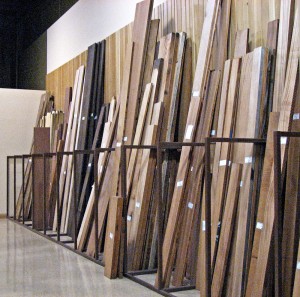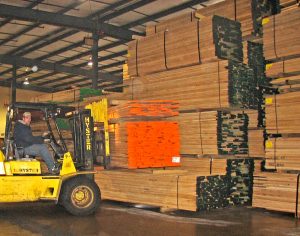We may receive a commission when you use our affiliate links. However, this does not impact our recommendations.
Whenever we convene a meeting of the “Should We or Should We Not Print Cutlists Debating Society”, we get tons of responses. In the latest instance an overwhelming number of poll participants voted yea, while most of the commenters said no, or gave a qualified yes – as long as we provide the lists online. So how do you use the cut list? There were many mentions of using it to plan wood purchases.
That’s one of the things you can use a cut list for, but generally I take the easy way out. If I’m planning a case piece, for example, I pretend it’s a big box and round up the width, height and depth to the next foot. Then I’ll multiply the width times the height to find out how many square feet of finished material is in the front, and depth times the height times two for the sides. Width times depth equals the top. This doesn’t take long at all and it gives me an approximation of how much primary wood will be in the finished piece. I factor in 50 percent more and I know I’ll be close.
In our neighborhood, there are places to buy nice hardwoods by the piece, at a cost of $5-$10 per board foot. This video gives an example, although I don’t have the cut list in hand. The method works, and it minimizes waste, but the cost per board foot is as high as it can be. My other option is to call a hardwood supplier out in the country and have a quantity of lumber delivered. This cuts the cost per board foot about in half, and if I purchase 100 board feet or more, I get a break in the price and delivery.
If I go through a cut list and do the math, I can determine the exact quantity of board feet in the finished piece, but that’s a serious waste of time. Board feet is a measure of volume, similar to a cubic yard of concrete. If I have a three-cubic-yard hole I want to fill, I can make a phone call and a truck will come out and pour that amount of concrete into the hole. Wood doesn’t work that way. If I call the lumber yard and order 25 board feet of hardwood, it could arrive in any number of configurations of random widths and lengths. Doing the math doesn’t do much good; in the end I either need to guess high to be sure I have enough, or work through the stack with my cut list in hand.
Most of the time the final cost will be close whether I go out and pick and choose, or order way too much and have it delivered. Where the cut list is important, to me at least, is when deciding which piece of wood goes where in the finished piece. I’m looking for different characteristics in boards that are mostly visual, as in tabletops or panels than I am for pieces that will become door frames. Having a lot of wood to root through to find the best piece available makes for better furniture. I guess I just don’t grasp the concept of “too much wood.”
Here is another video about buying hardwood lumber.
Here are some supplies and tools we find essential in our everyday work around the shop. We may receive a commission from sales referred by our links; however, we have carefully selected these products for their usefulness and quality.












The projects I see in the magazine are sometimes a thought starter, so I don’t use the cutlists. I can see how others might use them, but in reply to the idea of putting them on the web only, believe it or not, not all people have or use a computer.
More typical for me is to create a model on Sketchup. This slows me down so I take the time to see to the details; it’s a virtual build of the project and usually shakes out potential problems. Once I’m satisfied with the results, I make a cutlist of my project in Sketchup. For me this becomes my shopping list at the lumber store. I know how many wide boards, figured boards, rift sawn boards, etc., that I will need. I still add about 15% to each type of board, so I end up with enough wood, but not too much.
Love that Sketchup!
I too believed that one can’t have enough lumber but changed my mind when I closed my shop and moved it back home.
Don B.
When you’re a bit limited on storage space, there is, indeed, such a thing as “too much wood.” DAMHIKT.
I like and appreciate cut lists – although I use them only as a reference point – not an absolute. Instead of taking up valuable space in the magazine, how about just having a web link to download the cut list.
Just a thought.
Cheers
-g
As someone who’s a hand tool woodworker mostly out of necessity, and who works in a very tiny space in the backroom, I don’t have the luxury of storing much more wood than I need for the projects I’m working on. Yeah, I’d love to be able to store a few hundred board feet of something, but my circumstances require me to annoy the guys at the lumberyard by picking through every stick to make sure I’m not storing any more than I need to.
That said, I still don’t care for cut lists.
The points you bring up, Bob, about the cut list as a inferior method of calculating your lumber requirements are valid. However, that is only one reason to publish a cutlist. To me the cutlist is like the key to a map for a woodworking article. I can flip to it and quickly learn a lot about the size, complexity, details, hardware used, and overall dimensions of a project. It also is handy to make sure I have enough parts (was that 14 or 16 spindles for that Windsor chair???). To follow it slavishly is a bad idea,agreed, but having one around at least keeps you in the ballpark. That’s why I voted Yes, anyway.
I am a remodeler / woodworker. Cut lists are a useful analytical tool to help me parse the wood I will need against the wood I already have. They also help to reveal the writer’s intentions, providing info not revealed in the drawings. I would think that weekend woodworkers and newbies to woodworking might also find cut lists useful.
I know that we often see complaints in forums and blogs about incorrect lists and drawing dimensions, but what we do isn’t like building plastic model airplanes. We should always be double-checking the math and dimensions. I know I do.
I like cut lists. I also appreciate lists of hardware with suppliers.
The editors of the mag should put a little thought into the discrepancy of commenters being in the overwhelmingly “no” camp and voters being the overwhelmingly “yes” camp.
I can think of 2 reasons (but there may be more) – 1) the folks that want cut lists are vehemently indignant that anyone would even consider not providing them, and they voted 2, 10 or 100 times to ensure the outcome, or 2) the ones voting for cutlists somehow considered their opinion to be embarrassing in some way, and declined to comment.
Odd.
I am in the “no cut list” camp – not because I think they are evil, but simply because I find a dimensioned drawing a lot more useful. I very rarely – if ever – build a project exactly to the published plan anyway. But this is a personal choice thing, without a real “right” or “wrong” answer. If some folks really, really like the cut list, and it doesn’t cost the magazine a whole lot to prepare, then go ahead and print it and those of us who don’t use it can simply ignore it.
Hopefully the Cutlistists will learn after no more than one bad experience that they shouldn’t start their build by immediately breaking down their expensive lumber into precisely measured pieces as specified in the list!
I realize this will not work for many people, but I generally pick my project to fit the lumber I have on hand rather than purchasing the wood specifically for the project.
A great, down-to-earth explanation of how to figure out how much wood hopefully you need for a project from Bob. I think cutlists help people to feel a bit more secure in project planning, but in the end they’re just restrictive and have a tendency to force the project to follow a precise pattern instead of following the nature of the wood or the inspiration of the worker.
Please deliver that forklift of wood to my back yard.